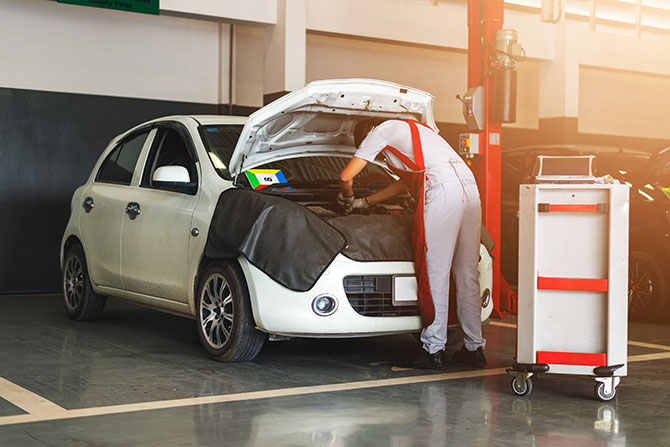The battle lines are being drawn across the nation in the ongoing kerfuffle between the OEMs and the dealer body over the use of the dealer’s retail labor time guide for warranty work.
“The bill is going to create hundreds of millions of dollars in costs every single year. That cost is going to get passed on to consumers.” — David Bright, Alliance For Automotive Innovation, is quoted in a March 29, 2024, New York Focus article by Chris Bragg and Julia Rock about a pending bill allowing the use of the dealer’s retail LTG for warranty work in New York.
At the outset, it’s important to keep in mind who designs, engineers, produces and controls the quality of the motor vehicles in question, who sets the MSRP and who extends the warranty to the customer. In each case, it is the OEM. Warranty repairs and recalls arise from flaws in the design, engineering and manufacturing processes — all controlled by the OEMs. It’s their problem, not the dealer and not the dealer’s technicians. Yet by David Bright’s own estimation, the OEMs are happy to shift “… hundreds of millions of dollars in costs every single year …” onto the backs of the dealers and their technicians to fix the shortcomings they themselves created and which they agreed by warranty to the customer to stand behind. The retail service customer should not be called upon to subsidize the OEM’s warranty expense because prices have to be increased to cover the shortfall in warranty reimbursement from the OEMs.
Every cost item in the manufacturing process is passed on to the consumer in the price of the goods. It’s no different with motor vehicles. If tires go up, the price goes up; if steel goes up, the price goes up; if manufacturing labor goes up, the price goes up.
Here in Montana, the OEMs are required to pay the same for warranty work, both parts and labor, as a retail customer would pay for the same job, including the use of the dealer’s retail labor time guide, and the debate has moved on to implementation. At least one OEM has accepted requests from dealers to use their retail labor time guide while at the same time advising the dealers that “nobody” is getting their request approved. At this point, that OEM appears to be as good as its word because none of its Montana dealers have received approval.
Some others, notably GM and Ford, have begun to recognize their obligations and begrudgingly taken steps to allow dealers to use their retail labor time guide for warranty repairs while at the same time designing strategies to parse every word and phrase of the statute into the narrowest narrative possible.
A few areas of contention have recently popped up, including “proof” by the dealer that the dealership uses only one retail labor time guide for all retail customers. Some OEMs have requested 100 sequential retail ROs demonstrating the use of only one retail LTG. One OEM, while initially requiring the 100 sequential ROs, will apparently now take a “certification” from the dealer concerning the LTG used instead of requiring the sequential ROs. It’s too early to tell whether such a “certification” will lead to more frequent warranty audits and what those audits might entail.
We also see evidence that OEMs are using different “workarounds” to avoid paying the dealer the required parts markup by purportedly using a third-party supplier or shipping the parts, particularly EV batteries, to the dealer at no cost. We believe the workarounds to avoid paying parts markup violates our statute as it requires that the dealer be paid the fair wholesale value of the part under 61-4-213(11) even if the part is furnished without cost.
61-4-213. Warranty reimbursement.
(11) If a motor vehicle franchisor supplies a part or parts to a motor vehicle franchisee at no cost or at a reduced cost for use in fulfilling a warranty, the franchisor must compensate the franchisee for the franchisee’s cost of the part, if any, plus an amount equal to the franchisee’s prevailing retail parts markup, multiplied by the fair wholesale value of the part. The fair wholesale value of the part is the greater of:
a. the amount the franchisee paid for the part or a substantially identical part if already owned by the franchisee;
b. the cost of the part shown in a current or prior established price schedule of the franchisor; or
c. the cost of a substantially identical part shown in a current or prior established price schedule of the franchisor. (emphasis added)
New issues seem to develop every time one of our dealers has a discussion with an OEM warranty rep. In an effort to stay on top of what is occurring in the field, MTADA Executive Vice President Bruce Knudsen and his staff are in the process of developing a comprehensive survey of the dealer body regarding what is taking place at the dealership level regarding retail labor time guide use and parts reimbursement. You may have already seen the survey. If not, it will be coming to your inbox soon. Please watch for it and respond as soon as you can. Once in, the survey results will be shared with the dealer body. In addition, substantial time at the MTADA Convention on Aug. 15-18, 2024, in Helena will be devoted to warranty reimbursement issues, including the OEM’s proposed “-0- cost” initiative on some parts, including EV batteries. You won’t want to miss that.









